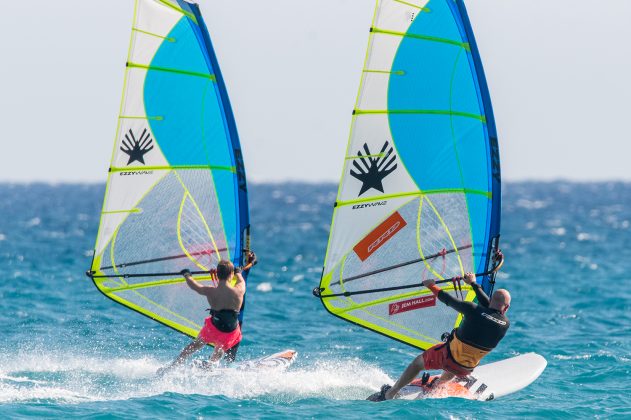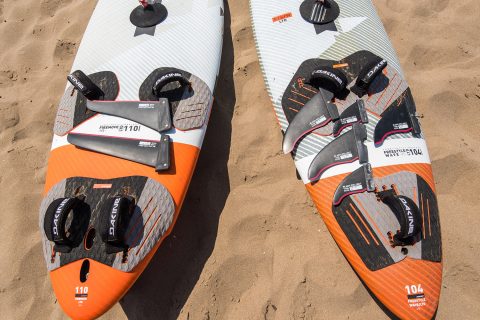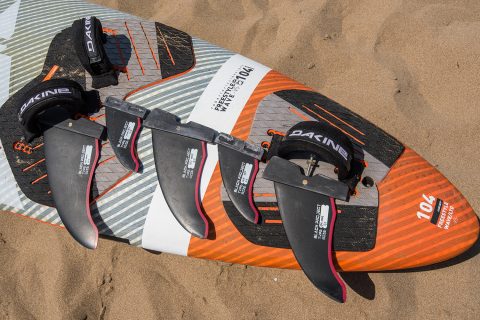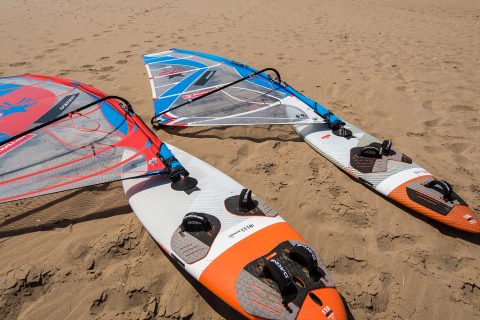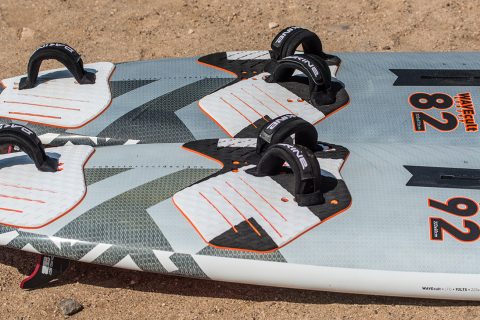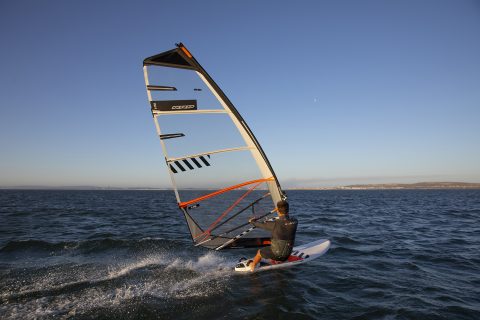JEM HALL
MOVE ON UP – WINDSURFING TECHNIQUE
QUIVER PLANNING
From our March 2021 issue of Windsurf Magazine, Jem Hall gives us his tips for the compilation of a modern quiver, with input from pro windsurfer and sail designer, John Skye.
Photos: Eye Sea You Photo // John Carter.
On my travels I often note people well equipped for windy days, but am often surprised how few had bigger gear (large freemove boards and sails above 6.5) or what I call improving / fundamentals gear. I have also seen a lot of people on fast cammed sails and slalom boards, and some of these people also have smaller gear. Yet they can be missing the kit in the middle, the easy freestyle wave (FSW) / crossover board or the small / medium freemove board.
Such easier to use boards or rotational sails can improve gybing and tacking skills and are just one example of how a well planned quiver can boost your sailing.
Tips to build a quiver
Think – Consider which boards best suit you and your sailing areas, your ability and aspirations. Then select the sails that will work best on these boards and that you will use!
- Increase your board’s range by having 2 – 3 fins for it and changing them accordingly. Photo by Eye Sea You.
Consider – With bigger sails and boards you can make bigger jumps in spacing and with smaller sails and boards you take smaller jumps between sizes. For example, sails you can easily go from 8.5 to 7.0, but often only 0.5 in smaller sizes, e.g. 4.5 to 4.0. This is down to the wind being so much weaker when it is lighter and yet it increases in power faster in stronger winds, above 18-20 knots. For boards we often need big platforms to support the bigger sails and yet when the wind is stronger we really do not need all that size. The difference between control in stronger winds on a 104 litre FSW @64 cm wide vs. a 90 litre FSW @60 cm wide is huge.
Break out – Don’t always follow the crowd. Know what you like and be aware of how your needs, skills and body weight can affect what will work best for you. I often advise light to medium weights to go 5.0, 4.5, 4.0 and onwards in their smaller sails, and when selecting their bigger sails, that a 6.5 feels so much smaller than a 7.0. Heavier sailors often follow the 5.3, 4,7 and 4.2 setup and for their larger sails, when they go big, they go very big, like a 7.5 or 8.0.
Treat yourself – Look at the optimum quiver spread for you, but don’t be frightened to throw in a sail that really suits your stature and boards, this might not be along the usual spacings. For me, whilst I now utilise a 5.5, 4.7, 4.1 quiver in the smaller sizes, I have added a 5.0 in here as it feels great and works so well on 3 of my boards (104 litre FSW, 94 and 82 litre wave boards). Plus this size of sail seems to have a huge wind range and it can mean I am not always on a sail that is too big or small on the most often occurring conditions I find myself in. What size are you missing in your quiver? Or what size sail just works for you and your boards over a whole range? Go on, go get it!
Mistakes to avoid
Measurement – When considering which board size, thinking about volume and not width or shape / performance style can give you a mismatched quiver. For example, the new freemoves are wide and therefore will feel bigger in float and planing. So you can indeed have in your quiver a wide freemove very close in volume to a FSW. In the RRD range for example this would be the 110 Firemove and the 104 FSW. They are quite far apart in early planing, float, actual size and top end control, due to their being 10 cm difference in max width between them, and very different plan shapes and tail widths too!
Assessment – People can be unrealistic about their actual ability, aspirations and the local conditions they sail in. This could be an intermediate choosing a big wave board with a lot of rocker for small cross on waves, when a tri fin easy to use FSW would be much more flattering and fun. It might also be not having a big enough board to take advantage of a plethora of force 4 winds over the summer months.
Cocktail – It can be the case that somebody might mix up powerful sails with flatter top end orientated sails in their quiver and these would then overlap. For example a powerful 5.8 with a flat / fast 6.5 could be very close in terms of power. Decide your desired feel in the smaller sizes and identify what you want out of your bigger sizes. People may also have a mix of sail brands in one quiver and they will often feel and rig differently and may actually overlap with the next size up or down. One brand’s powerful 4.7 can be close in terms of power to another brands flatter cut 5.2 for instance.
Wrong tools – Too short or too long a mast in a sail can accordingly either make the sail feel too soft or too stiff. This mainly occurs when people have a long mast in small sails. If you want the absolute best out of a sail, then use the mast that is recommended to accompany it.
- Small single fin, and then a thruster set with 2 rear fin options gives you lots of range on a tri fin FSW.
Fin change – If we only use the stock fin that comes with the board we will only get a certain range out of it. Changing the fin/s up and down in your board can give it a much wider range. Bigger freemove boards can work with 3 different sized fins for example. A bigger fin may even mean you don’t need such a big sail!
Incompatibility issues - Pairing a medium sized FSW with a big 7.0 or placing a 3.7 on a big FSW is just not compatible. Smaller boards simply can’t support bigger sails and medium to bigger boards like to have a bit more engine and do not work with sails that are too small.
Spread it about - I have seen a few car parks where people have a really pricey car and really old kit. Kit is so good now and life is short, so get the toys that help you rip and enjoy.
Minimum quiver
I have had great success recommending the 3 and 2 quiver to many people who are looking to get the best out of their sailing in medium to strong winds and around the intermediate level.
This would be:
- 3 sails, 3 masts and 2 boards.
- The bigger sail would be a 7.5 to 6.5, the medium sail would be 5.8 to 5.2 and the smaller sail around 5.0 to 4.7.
- These would go with a freemove board between 110 and 125 litres from 72 – 80 cm wide and a FSW tri fin between 110 and 90 litres.
- Add in lots of sail tuning and at least two fin options for the boards and this gives you a huge range.
- The medium sail works on both boards and then you can often change boards, up or down, should the wind drop or increase.
- 6.5 and 5.8 are interchangeable on both freemove 110 and FSW 104 boards and are an option in Jem’s recommended 3 / 2 Minimum quiver. Photo by Eye Sea You.
Maximum quiver
For this example I will use my quiver. I need different sails for my various coaching trips and also for coaching and freesailing in Oslo. It will carry me from very light winds to very windy days.
- Light to medium winds: 7.5 and 6.5 rotationals to go on my Firemove 120 and 110, and my Pocket Rocket foil board, with an easy high rise foil.
- Medium to strong winds: 5.8 5 batten sail, 5.7 foil sail, and 5.5 4 batten sail to go on the Firemove 110, FSW 104, and foil board.
- Windy: 5.0, 4.7, 4.1, 3.7 4 batten sails to go with 104 FSW and 94 and 82 litre Wave Cult boards.
I am 90 kg and so a wave board around my body weight works great, and yes even at this weight I need the 82 as when I am overpowered on 4.7 or smaller, on some wave breaks, the 92 can get quite big and unmanageable both in the water and in the air.
My sails and boards have a big range and I tune them to take it even further. Living in Oslo and travelling for clinics what has impressed me the most is the range of a modern tri fin FSW from 5.8 bump and jump with a big fin to windy wave sailing on a 4.7 and a tri fin setup, it just works and gives me a lot of great days.
- At 90 kg Jem uses a 92/94 wave board the most, and for the windier days he needs an 82. Having two boards from the same range means they will feel similar, and only differ in size’
Extending your quiver range
Perhaps you are on a minimum quiver or don’t own much kit or you just want to get the most bang for your buck from your toys, so here are some tips to do just this:
- Keep on it – If the wind drops or increases don’t head to the beach, ‘keep on it’ and work with your gear to get more accustomed to it and also perhaps to being out of your comfort zone and then whilst doing this take the next bit of advice.
- Tune – You can really get a vast range from your board by moving the mastfoot, tweaking footstrap positions and changing fin sizes, or the style of fin. For sails you can change the outhaul, downhaul and boom height. These are covered in my tuning articles in back issues or on www.windsurf.co.uk.
- Get advice – Your local shop or ripper, a brand or a coach, can advise on how best to set up your gear and extend its range.
- Make a change – Some of your kit decisions may have been made with less effective judgement and so you stick with it as you are now connected to it emotionally and perhaps don’t want to admit you made a mistake. Sometimes you have to cut your losses and start afresh with more suitable equipment and review how certain sails or boards fit in your quiver.
New developments
In the last 5 years I have seen people get back into bigger boards to get more water time as the new style of freemove boards have so much range and are so fun to gybe and sail.
People are also choosing and using more all-rounders and FSW boards rather than wave boards.
I believe wave sailing is so much more accessible now because of these easy sailing and turning 3 fin FSW boards. Add to this the fact that bigger wave sails are now more available and have even greater range than before.
Lastly, in wave boards, many of them now have 5 fin boxes, and are more all-round in their performance and this can thereby help us increase their range or help you find the style you like. For example, setting up some wave boards as a quad can often boost their top end control and grip.
Skye’s view
Seeing as I do not use cammed sails hardly ever and love my rotationals, I will hand over to John Skye for his take on twin cams vs. rotationals and he will also outline his own personal quiver.
John Skye – “Personally I think early planing is not really heavily related to cams or no cams. You can have twin cam sails that are very top end biased, touching on race sail performance. These will typically have less bottom end, but an incredibly high top end, almost never losing control no matter how windy it gets. On the other hand the best early planing sail for RRD is our 6 batten large Evolution sail. This has tonnes of power and is designed more for static planing rather than a more dynamic planing style. Just sheet the sail in and go. With less battens/cams the sail has less structure and therefore can really fill in to generate power. The downside is obviously at the top end, where this lack of structure results in less stability and therefore less control, but if early planing is the goal in a nice light easy to use package, it is the best.
- John Skye blasting on his RRD ‘Firemove’ freemove board. Photo by John Carter.
Skye’s quiver
For a pure wave quiver I think a board around your weight in litres, or a touch bigger, is a great all-round size. If you have the $$$$, it is worth adding a larger board approximately 10-15 litres more for the light wind days. If you live somewhere where the conditions are mostly bump and jump, that big board can be a freestyle wave to give you an even bigger range. I am quite spoilt so my quiver is normally 82 and 94 litre wave boards. That covers me for everything from 8 knots float and ride, to 50 knots Pozo. Some different fin setups can further increase that range.
For sails I normally start with the biggest, which for me is always the trusty 5.3. Then I would go 4.7, 4.2 and 3.7. If I wanted to reduce the number of sails a 5.0, 4.5, 4.0 quiver is also pretty nice and is typically the quiver I would take to Cape Town for example. If you live somewhere with very consistent winds it is worth having closer sizing in that range. Here in Gran Canaria in the summer, it is really beneficial for example to have 4.2, 4.0, and 3.7, to make sure you are always comfortable. In Maui for example a 5.3, 5.0, 4.7 quiver is almost essential to get the most out of it.
Finally to get going in the real light winds you now have endless options with the foils. My favourite at the moment is a 5.8 Compact free foil sail with a Pocket Rocket board and Universal foil. This setup is super light, really easy and gets up and going in nothing and can carry me through to wave sailing conditions. I think if I was based somewhere with lots of days of light winds I would probably go for a large freeride foil/fin setup to give me huge range. For the really light days a large freeride board with a foil and something like a 7.0m no cam freeride sail. Then in the 12-15 knot range, change the foil to a fin and keep the same sail and board.
RRD boards, wetsuits & softwear, Ezzy sails & Black Project fins sponsor Jem Hall. Get him live and direct on one of his highly acclaimed coaching holidays, but be quick as they are selling out – check out his website www.jemhall.com for details. You can also follow him on twitter / Facebook / Instagram.

